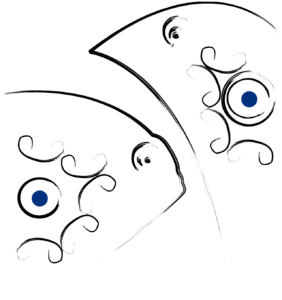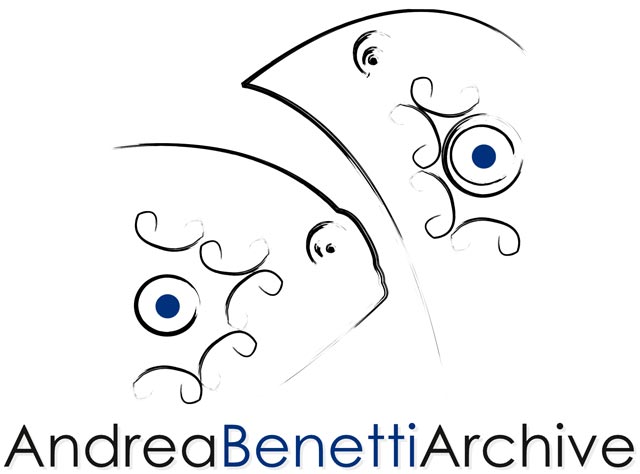Andrea Benetti’s Neo-Cave Painting
The Bolognese artist Andrea Benetti, author of the “Neo-Cave Art Manifesto”, shares his story in an interview with monitorARTI. Born in 1964, he studied at the Art High School of Bologna, cultivating an interest in both art and music. His painting, which blends oil colors with natural elements such as cocoa, coffee, hibiscus, and henna, draws inspiration from the marks that primitive humans traced on cave walls—whether to invoke the divine or simply out of an innate need for expression.
Andrea Benetti has exhibited in prestigious exhibitions, and his works are included in the collections of galleries and museums worldwide. Last May, he met with students of the Contemporary Art History course at the University of Salento for a seminar on Neo-Cave Art.
AG: Before the advent of writing, humans satisfied their primal need to communicate through the visual language of painting. Contemporary man has severed the pantheistic connection that once bound him to nature, placing himself at the center of the universe. In the “Neo-Cave Art Manifesto”, drafted in 2006 and later presented at the 53rd Venice Biennale, there is a clear urgency to return to primordial art, restoring a state of uncontaminated purity by rejecting the dominance of advertising and consumerism. What does Neo-Cave Art mean to you?
AB: Neo-Cave Art is a moment of reflection, a constant reminder of human origins, reminding us that we are an integral part of nature—and that by poisoning nature, we are ultimately poisoning ourselves.
It is a symbolic means, through artistic expression, to start over from zero—beginning at the origins of humanity, with respect for the environment and human dignity as central priorities. These are values too often trampled in the name of economic growth, which enriches oligarchies while cunningly manipulating the minds of the masses to serve its own interests.
Neo-Cave Art is also a way of holding onto hope—hope for a fairer society, for a genuine sense of solidarity, one that is not hollow rhetoric or exploited for personal gain, as too often happens.
Lastly, Neo-Cave Art is also a way for me to “play” with our history. I like to maintain a playful element in my painting—the childlike spirit within me, which often emerges in my work.
AG: “Homage to Cave Painting,” “The Abstraction of Origins,” and “A Primitive in the Third Millennium” are the three categories into which your works are divided, each characterized by a strong playful component. Can you elaborate?
AB: Homage to Cave Painting pays due tribute to the men who, tens of thousands of years ago, felt the need to communicate visually, to leave a trace of themselves—even venturing into the deepest recesses of caves, risking their lives in the process, since at the time, predatory animals could easily devour humans.
These early artists deserve immense recognition for having invented art—or rather, for being the first to manifest it. I believe that the need to create art is intrinsic to much of humanity.
The Abstraction of Origins serves as a concrete reminder—as if one were needed—that abstraction, figuration, symbolism, and conceptualism had already been conceived by prehistoric humans, at least in their embryonic forms. The geometric shapes found in cave paintings, the symbols studied and codified by André Leroi-Gourhan, are reinterpreted, transfigured, idealized, dreamed, and reinvented in my paintings. They are a tribute to the abstraction of origins.
The category I call “A Primitive in the Third Millennium” is partly explained in my previous answer—it is the child within me, who playfully imagines what a prehistoric human would depict today on a hypothetical rock wall.
As I often joke, it certainly wouldn’t be horses or bison, since these animals rarely roam modern cities. Instead, they would depict the icons of our civilization—our modern-day imagery.
That’s why my works portray sailboats, golfers, cars, airplanes, motorboats, trains, as well as flowers, meticulously crafted with aesthetic precision. In my imagination, and in the playful spirit of my never-dormant inner child, this is what today’s cave dwellers would be painting on their rocky canvases.
AG: “Unusual Exploration of Speed” is the title of your 2009 book, in which you articulate your ideas on speed in relation to historical cycles and the evolution of civilizations—through painting. What “unusual” theories did you develop?
AB: First of all, I’m not a philosopher—or at least, I’ve never considered myself one.
However, I have formulated a thesis, proposing that our obsession with accelerating society—and, by extension, our very existence—is ultimately an attempt to exorcize our fear of death.
By frantically filling our lives with events (obligations, commitments), we create the illusion of living longer, as if this could somehow soothe our deep-seated longing for eternity.
In the book, I introduce what I call the “Accordion Theory”, comparing our lives to the bellows of an accordion. The musician, in an attempt to extend the accordion’s range, adds more folds to the bellows—just as we pack our lives with more experiences.
But just as the accordion’s extension is ultimately limited by the length of the musician’s arms, the same applies to life itself. Adding more folds (more events) does not extend the actual duration of life—it only risks compromising its quality.
This obsession with speed, this drive for acceleration, is part of modern man’s delusion that he can exercise absolute control over everything.
In my work, I represent this all-encompassing desire for control through a new symbolic language—specifically, the stylization of the eagle and the whale (a symbol that has also become my personal logo).
These two animals are paired because the eagle flies higher than any other creature, while the whale swims in the deepest ocean abysses. Between these two extremes, everything else exists—the world itself.
AG: Last September, the ancestral setting of “La Grave” Cave in Castellana Grotte (BA) served as the backdrop for your exhibition “Neo-Cave Painting”. How did the natural setting enhance the experience, given that your works are so intimately connected to it? And what future locations will serve as scenic venues for your exhibitions?
AB: Being inside that “museum of nature’s magnificence”—the Castellana Caves—moved me more than any traditional museum, no matter how prestigious or beneficial to my artistic career.
Placing my works within a setting of eternal beauty was an experience beyond any expectation.
Seeing certain elements from my paintings—inspired by cave art—projected onto the cave walls in gigantic dimensions (6 x 4 meters), blending seamlessly into the rock, was incredibly rewarding.
Even the exhibition path, featuring seven displayed works, was curated with the same level of excellence as a modern museum.
For the future, I have a couple of major projects lined up—but out of superstition, I won’t reveal them yet. However, I will say this: I aspire to repeat the cave exhibition experience in Italy’s most significant caves, provided I find the same visionary support that I found in Castellana Grotte.
Antonella Gallone |
Journalist and Art Critic |




